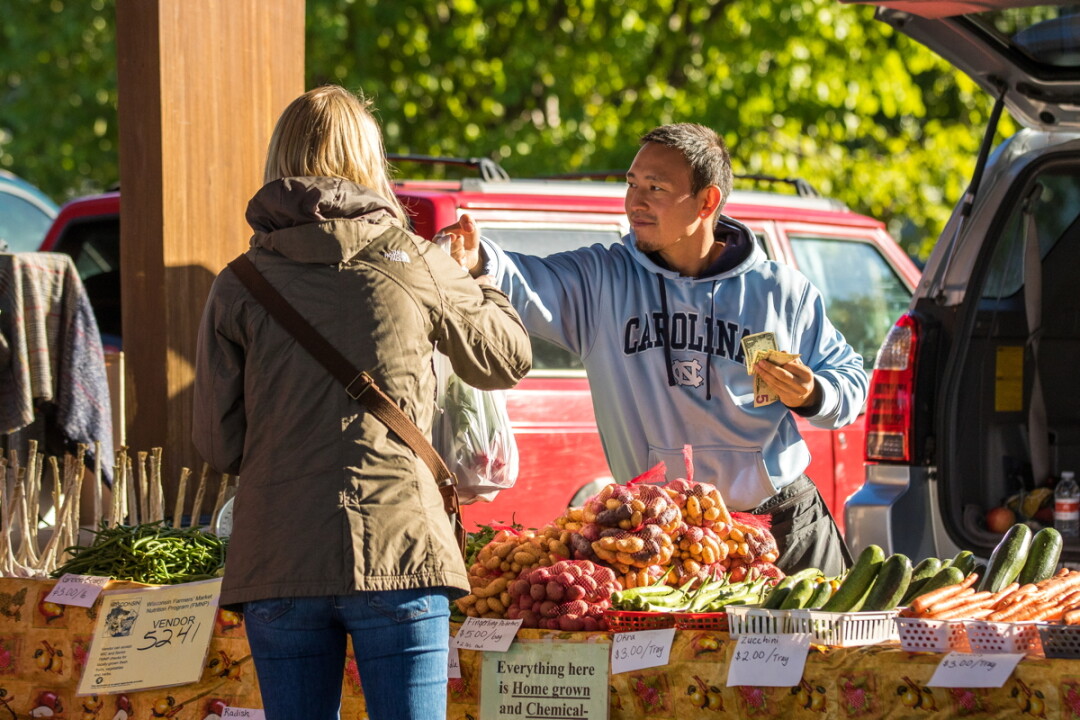Transnational Tradition: Generations of Hmong vendors are part of Downtown Eau Claire Farmers Market
Lauren Fisher, photos by Andrea Paulseth |

A walk through the Eau Claire Downtown Farmers Market on a Saturday morning is a treat for the senses. A faint breeze through the pavilion carries the sound of music, footsteps, and conversation, as well as the smells of fresh bread and plump strawberries. And don’t forget the samples: Cheeses, breads, and more are available for a tantalizing taste.
When all the vendors are present, nearly half of this walk is provided by Hmong vendors, according to Deidra Barrickman, the market manager. Out of 75 vendors at the market, 36 are owned and operated by Hmong families who live and farm in the Chippewa Valley.
“Hmong people do it out of joy. Farming, it’s in our blood.” – Ashley Her, 16, on the Farmers Market tradition in her family
Many Hmong individuals and families came to the Chippewa Valley from Southeast Asia as political refugees between 1970 and the 1990s following the Vietnam War. Wisconsin has the third highest population of Hmong people in the United States, after California and Minnesota.
“It seems like a gift to be able to know about their culture, and a lot of times, some of their stories about how they got here to the United States,” Deidra said.
One such farmer is Mee Xiong, originally from Laos, who came to the United States in 1980. She is 75 years old, and has been selling food and flowers in Eau Claire since 1988. She would wake up early in the morning to tend her garden before driving an hour to Barron, where she worked at the Jenny-O Turkey Store. At first she rented land to grow on, but eventually saved enough to buy five acres, where she now lives and gardens. On market days she was up and selling at the wee hours. Now, she is retired, but she still works the markets.
“We’ve been working in the farmers market for long, long years,” Mee said. “I like the farmers market. My older daughter said, ‘Mommy, don’t work so hard. You don’t need money. You don’t need to worry. You have good children, your children have a job. Stay home, go vacation.’ ” But Mee enjoys her work; she says she doesn’t sleep well if she doesn’t tend her garden.

A few booths down from Mee on a Wednesday morning is Ashley Her, 16, who drove from her family’s farm in Minnesota to sell fresh flowers.
“Hmong people do it out of joy,” Ashley said. “Farming, it’s in our blood.” She also observed that growing and selling food was a way for Hmong people to make a living, as many of them had farmed in Laos to feed their families. Armed with generations of farming knowledge, Hmong immigrants were able to sell vegetables even if they didn’t speak English.
Kevin and Pa Chia Xiong, siblings in their mid-to-late 20s in a neighboring booth, think that farming is traditionally just part of being Hmong. They man their family’s Eau Claire stand while their parents travel to Madison markets. The smell of fresh onions and herbs wafts up from their booth. Pa Chia relayed the story about how their parents met in Laos, in a refugee camp. Her father moved to Eau Claire via Portland and Chicago, while her mother travelled through France, then Connecticut, before they were reunited in the Chippewa Valley. She joked about how methodical their parents are about farming, planting at just the right time and stringing up beans as they grow.
By Deidra’s observation, as Hmong families grow and children get older, many begin to pursue other interests. “I do think that we’re going to have more of our Hmong vegetable growers that are going to resign from the market mostly because of age and not being able to grow the gardens anymore,” she said.
Ashley, Pa Chia, and Kevin see this trend as well. This will be Ashley’s last year gardening with her family, she said, as she enters her senior year of high school.
“I feel like for my future, education is just more important,” Ashley said. “So I should focus more on that, and on the side come back and do some gardening, help out my grandma.”
Kevin has plans to pursue a career in music, while Pa Chia, a photographer, wants to move forward in photography and social media.
“I think there’s definitely going to be a lot less vegetable produce because of the Hmong people,” Kevin said. “We do have other goals, other interests as well, so we kind of want to go and do our own things.”

However, they see an opportunity for new vendors to move into the local produce market. “More urban people will come in, more urban farms will start to produce and younger people, 30s to 40s, will be more interested in creating their own urban farm,” Pa Chia predicts.
“Once the Hmong vegetable farmers don’t exist anymore, I think more people will find interest, more people will start growing their own vegetables to sell here,” Kevin added.
“We need to look to some of these young farmers who are applying and try to find a spot for them,” Deidra said. “This is so important to our market, that customer and producer get to have a relationship.”
In the mean time, Pa Chia does make connections with shoppers at the Eau Claire Downtown Farmers Market. She talks to visiting college students and families, sharing recipes and knowledge of the produce before she goes on to other work and interests.


















